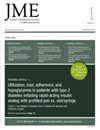实时连续血糖监测与自我血糖监测:使用强化胰岛素的韩国 2 型糖尿病患者的成本效益。
IF 2.9
4区 医学
Q2 HEALTH CARE SCIENCES & SERVICES
引用次数: 0
摘要
目的本研究调查了在韩国接受胰岛素强化治疗的 2 型糖尿病 (T2D) 患者中,实时连续血糖监测 (rt-CGM) 与自我血糖监测 (SMBG) 的成本效用。方法采用 IQVIA 核心糖尿病模型 (CDM v9.5),临床疗效数据来自一项大规模的实际研究。成本来源于韩国,并膨胀至 2022 韩元(KRW)。从韩国支付方的角度出发,采用终生视角,未来成本和效果以每年 4.5% 的速度贴现。基线特征包括平均基线 HbA1c 水平为 8.6%(71 mmol/mol),平均年龄为 64.4 岁。结果 rt-CGM 比 SMBG 增加了 0.683 个质量调整生命年(QALYs)(rt-CGM 增加了 7.526 个 QALYs,SMBG 增加了 6.843 个 QALYs)。rt-CGM 的成本增加了 1640 万韩元(从 9,040 万韩元增至 1.068 亿韩元)。结论对于韩国接受胰岛素强化治疗的 T2D 患者而言,相对于 SMBG,rt-CGM 具有成本效益。本文章由计算机程序翻译,如有差异,请以英文原文为准。
Real-time continuous glucose monitoring vs. self-monitoring of blood glucose: cost-utility in South Korean type 2 diabetes patients on intensive insulin.
AIMS
This study investigated the cost-utility of real-time continuous glucose monitoring (rt-CGM) versus self-monitoring of blood glucose (SMBG) in people with type 2 diabetes (T2D) receiving intensive insulin therapy in South Korea.
METHODS
The IQVIA Core Diabetes Model (CDM v9.5) was used, with clinical effectiveness data obtained from a large-scale real world study. Costs were obtained from South Korean sources and inflated to 2022 South Korean Won (KRW). A South Korean payer perspective was adopted over a lifetime horizon, with future costs and effects discounted at 4.5% per annum. Baseline characteristics included a mean baseline HbA1c level of 8.6% (71 mmol/mol), and a mean age of 64.4 years. A willingness-to-pay (WTP) threshold of KRW 46.0 million was used.
RESULTS
Rt-CGM led to an increase of 0.683 quality-adjusted life years (QALYs) versus SMBG (7.526 QALYs for rt-CGM versus 6.843 QALYs for SMBG). An increase in costs of KRW 16.4 million (from KRW 90.4 million to KRW 106.8 million) was associated with rt-CGM. The incremental cost-utility ratio was KRW 24.0 million per QALY gained, significantly lower than the KRW 46 million threshold.
CONCLUSIONS
For individuals with T2D managed by intensive insulin therapy in South Korea, rt-CGM is cost-effective relative to SMBG.
求助全文
通过发布文献求助,成功后即可免费获取论文全文。
去求助
来源期刊

Journal of Medical Economics
HEALTH CARE SCIENCES & SERVICES-MEDICINE, GENERAL & INTERNAL
CiteScore
4.50
自引率
4.20%
发文量
122
期刊介绍:
Journal of Medical Economics'' mission is to provide ethical, unbiased and rapid publication of quality content that is validated by rigorous peer review. The aim of Journal of Medical Economics is to serve the information needs of the pharmacoeconomics and healthcare research community, to help translate research advances into patient care and be a leader in transparency/disclosure by facilitating a collaborative and honest approach to publication.
Journal of Medical Economics publishes high-quality economic assessments of novel therapeutic and device interventions for an international audience
 求助内容:
求助内容: 应助结果提醒方式:
应助结果提醒方式:


